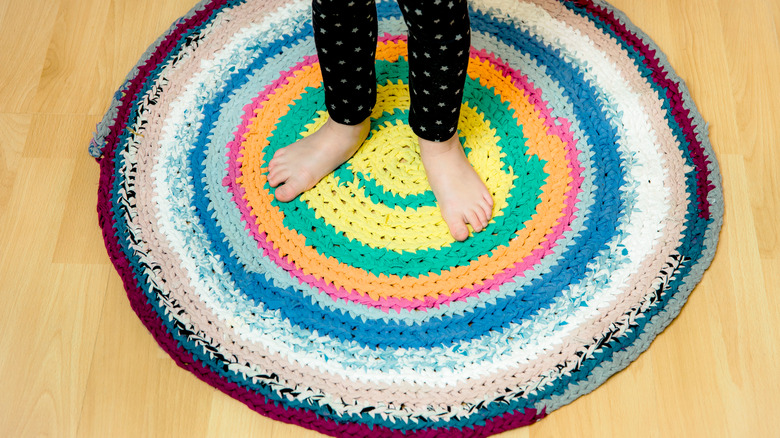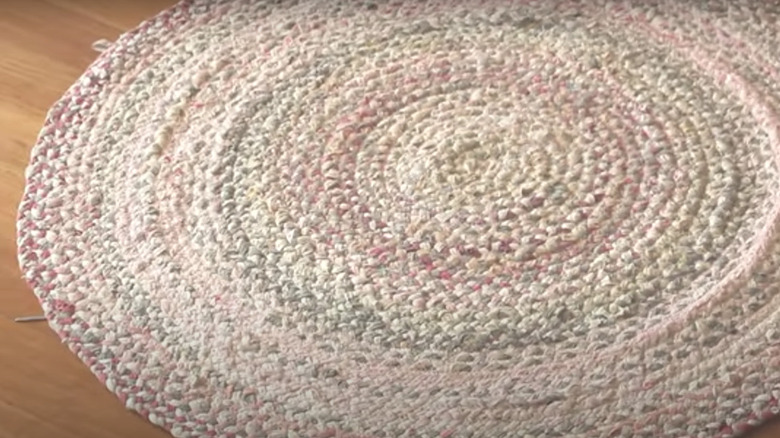How To Make A Braided Rag Rug From Old Sheets Or T-Shirts
It probably won't surprise you to learn that in the US we're running out of space when it comes to landfills. We've mentioned how to make your home eco-friendly. We can only throw away so much garbage before it comes back to haunt us. Fortunately, there's a grass-roots movement afoot to upcycle and recycle everything we can. Bulky items like old clothes, t-shirts, sheets, jeans, and just about anything that's too stained or torn to pass along can be given new life as a braided rag rug, rather than ending up unused in a dumpster.
We can't pretend this is a new trend, since women in Colonial America, loathe to waste anything of possible value, reinvented old clothing as braided rag rugs. The idea of making use of everything before tossing it was and still is a valuable instinct.
The technique is simple. Cut or tear lengths of sheets or clothing into strips one inch wide. Tie, sew, or tape down the ends of three strips. Braid along their length so the strips become rope-like, watching your tension, and adding in new strips just as the old one gets used up. Then use an upholstery needle to sew the rope segments into a circle, oval, or rectangle. Your old materials are repurposed, and you have a new rug for your bathroom, kitchen, mudroom, or any other space that needs a touch of softness.
Endless Possibilities
@rebelleboutique9 Create your own rug with recycled bedsheets, braid them then sew them together in a round shape! #diyrug #handmaderug #braidedrug #fabricripping #diy
The material you work with will dictate where your handmade rug will work best. A rug made from flannel sheets and cotton t-shirts is a rug that absorbs water beautifully, and that rug is best suited for the bathroom or laundry. If you're braiding your rug from old jeans and linen, you're making something that's highly durable, that might work best as a mat by the front or back door. You're only limited by your imagination. We've seen rag rugs made of nothing but socks.
Note that the design can be as colorful or as muted as you wish. Some rugs present a veritable rainbow of colors. Others are studies in denim and other shades of blue. Or organize by color using old clothing and bedding. Take a shot at decluttering your linen closet and we're sure you'll be inspired. One caution – try to keep braided fabrics the same weight so you end up with smooth, pliable braids. Mixing t-shirts with sheets is a great example of what will work. Mixing towels with sheets is a great example of what will give you lumpy, bumpy, uneven braids that are difficult to work with and uncomfortable to stand on.
On TikTok, user @rebelleboutique demonstrates how to use an upholstery needle and thick thread to hold the rug together in the shape you envision. Apply the stitches to the underside of the rug, making the presenting side a comfortable pad to stand on, and use in rooms throughout your house.
Wash as needed
As convenient and easy to make as these rugs are, not to mention the personal touch they give your home, take some care when cleaning them. Know that dirt can get in between the various braids, leaving a dusty "footprint" on the floor underneath.
You may opt for spot cleaning, or outside, blasting a cold spray of water onto the rug to remove dust and dirt. Depending on its size, a braided rug can go into the washing machine by itself, so it has plenty of room to tumble. Use the gentle cycle with cold or cool water. Larger rugs can go right into the bathtub where you can add mild soap and squish it around with your hands or feet. Be sure to give it several rinses. No matter which way you wash your rug, dry it by picking a day that's warm and sunny. Wrap it in beach towels to absorb excess moisture, then roll it out, allowing it to dry flat in the sun. If that's not going to work, your rug can go into the dryer on medium heat, not high heat. Take a look to see if it needs any resewing on the underside to keep its shape. Also, look for ragged ends on the presenting side, and trim stray threads away with scissors or a sharp razor. Steam cleaning is a great alternative as well.

